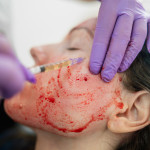I was tired of constantly being told how gaunt and haggard I looked,“ says San Francisco PWA Steven Miller, now on protease inhibitors for two years. ”Especially when my T-cell count was up, my viral load undetectable, and I felt better than I had in years."
Body wasting, common with HIV, is often accelerated in the face. Antiretroviral cocktails are giving many a new lease on life, and anabolic steroids (testosterone and/or related drugs) combined with good nutrition and exercise is transforming skin-and-bones bodies into cut-and-buffed stud muffins. Unfortunately, even with the best antiwasting regimens, the body often fails to restore facial fat. And that emaciated face staring back in the mirror fails to reflect the resurrected inner self. But with a minor miracle of cosmetic surgery – and lots of bucks – a face may regain its former glory.
There are several options for restoring normal facial contours. Body-fat transfer involves “harvesting” (a gentler version of liposuction) fat cells from fat-containing body locations (groin, abdomen, buttocks), and then injecting them into the layer between facial muscles. Chicago PWA Stan Reiter (not his real name) desperately wanted to reverse his severe facial wasting. Jeffery Brande, MD, a plastic and reconstructive surgeon in Manhattan, used an epidural spinal block – an anesthetic injected near the spine – to numb Reiter’s lower body so that fat could be painlessly removed from his groin and abdomen. The fat cells were then injected into his face, in three-and-a-half-hour procedure. The resulting swelling and slight bruising under his eyes caused little discomfort. Because he was extremely thin, making the fat harvesting more difficult, Reiter experienced some abdominal pain for several weeks. For most people, the pain is minimal and lasts for only a day or two. Four months later, Reiter says: “I’m extremely happy with the results. People are so amazed at the dramatic change.”
Brande, who has performed the procedure on several dozen HIV positive men, notes one limitation. “I have patients waiting for injections because they don’t have enough body fat to harvest. Some need to gain fat before I can proceed.” Like Reiter, they may need to temporarily curt down on workouts, and increase their dietary fat (if that’s possible without setting off diarrhea, a common result from too much fat in PWAs’ diets).
If injected correctly, the fat cells remain in position long-term. “The implanted fat cells take up space,” Brande says, “but are not hormonally connected to the body, and do not function in the way fat cells normally do. Thus, they are not reabsorbed by the body.” None of Brande’s patients have developed post-surgical infections. The only common after-effect is swelling and bruising.
A second option is cheek implants. In an hour-long outpatient operation, a silicon implant is inserted over the bone through an incision inside the mouth above the gum. This technique was chosen by Steven Miller, whose surgery was performed by Michael Echavez, MD, a San Francisco cosmetic surgeon. Miller reported only minor discomfort after his implant last spring, with the swelling disappearing within four or five days. Though not dramatically changed, his cheeks do appear less gaunt and hollow. Echavez says, “If the right implant is chosen and placed correctly, it will look natural.”
Although some reconstructive surgeons worry that exposure to bacteria-loaded saliva – inevitable with this procedure – could lead to serious infections in PWAs, Echavez’s experience is that complications are uncommon. “Rarely does an infection develop,” he says. “I’ve had a couple of patients complain of pain on one side a year later. With two of them I’ve temporarily removed the implants, but both patients elected to have them put back in.”
Another option for facial reconstruction is injected collagen. However, the results are not permanent. After three to nine months, the injections must be repeated, with costs ranging from $600 to $1,200. In comparison, Miller’s cheek implants priced out at $2,500, and Reiter’s fat injections at $%,250. (Few of these procedures are covered by insurance; check your policy.) When properly done by an experienced plastic surgeon, both options will usually result in permanent changes for the better.
Clearly, not everyone can afford the procedure, but Reiter says: “To me it was well worth it. If I had 50 T-cells and my viral load was still high, I wouldn’t have done the fat injections. I may be vain, but I don’t care about looking good in my casket. But now that it seems I’m going to be here awhile, I want to look as good as I feel.”






Comments
Comments